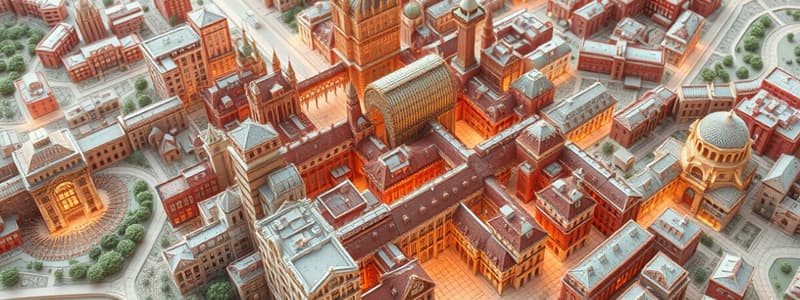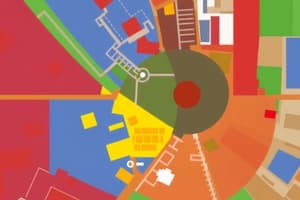Podcast
Questions and Answers
What is the area of use for the Sector Model?
What is the area of use for the Sector Model?
- Metropolitan Areas
- Rural Areas
- Suburban Areas
- Cities (correct)
Who is the author of the Sector Model?
Who is the author of the Sector Model?
Homer Hoyt
The Sector Model was based on central railroad transportation.
The Sector Model was based on central railroad transportation.
False (B)
Which of the following is NOT a feature of the Multiple Nuclei Model?
Which of the following is NOT a feature of the Multiple Nuclei Model?
Who authored the Multiple Nuclei Model?
Who authored the Multiple Nuclei Model?
What does the Urban Realms Model explain?
What does the Urban Realms Model explain?
The Urban Realms Model promotes dependence on public transport.
The Urban Realms Model promotes dependence on public transport.
Who is the author of the Concentric Zone Model?
Who is the author of the Concentric Zone Model?
What is the main concept of the Concentric Zone Model?
What is the main concept of the Concentric Zone Model?
The Concentric Zone Model accounts for environmental factors.
The Concentric Zone Model accounts for environmental factors.
What is a strength of the Southeast Asian City Model?
What is a strength of the Southeast Asian City Model?
Who is the author of the Latin American City Model?
Who is the author of the Latin American City Model?
The Latin American City Model promotes significant commuting distances.
The Latin American City Model promotes significant commuting distances.
What does the Sub-Saharan African City Model illustrate?
What does the Sub-Saharan African City Model illustrate?
Flashcards are hidden until you start studying
Study Notes
Sector Model
- Developed by Homer Hoyt in 1939.
- Key components: Central business district, transportation and industry, low-class residential, middle-class residential, high-class residential.
- Growth occurs in sectors rather than concentric circles.
- Strengths: Allows for outward progression and addresses shortcomings of Burgess's model.
- Weaknesses: Based on railroad transportation; does not account for car usage.
Multiple Nuclei Model
- Created by Harris and Ullman in 1945.
- Components include central business district, various residential layers, and multiple centers for business and manufacturing.
- Recognizes cities as structures with multiple activity centers.
- Strengths: Reflects decentralization and social-economic group distribution.
- Weaknesses: Lacks consideration of physical geography and doesn’t explain demographic specifics.
Urban Realms Model
- Proposed by James Vance in the 1970s.
- Reflects urban growth patterns linked to automobile use and development of suburban realms.
- Suburbs include mini-CBDs, independent from original central business districts.
- Strength: Each realm functions economically, enhancing overall metropolis self-sufficiency.
- Weakness: Can lead to urban sprawl if model is ineffective.
- Effectiveness: Adapted to accommodate large populations and automobile dependency.
Concentric Zone Model
- Introduced by Ernest Burgess in 1923.
- Suggests cities grow outward in a series of concentric rings: central business district, transition zone, independent workers' homes, better residences, commuter zone.
- Strength: Represents urban development patterns of the 1920s.
- Weakness: Fails to consider changes in urban landscapes and environmental factors.
- Effectiveness: Historically based on Chicago, but increasingly outdated.
Southeast Asian City Model
- Developed by T.G. McGee.
- Illustrates residential zones radiating from the center; high-class areas closer, low-income on the periphery.
- Strength: Highlights diversity through a commercial zone.
- Weakness: Distances markets from ports affect trade.
- Effectiveness: Suits many developing middle-sized cities, but aspects are subject to change.
Latin American City Model
- Crafted by Ford and Griffin in 1980.
- Incorporates Latin American culture, colonization effects, and globalization influences.
- Strength: Simplified geometric layout; proximity of markets to residences reduces commuting.
- Weakness: Poor residents’ outskirts can lead to higher crime rates.
Sub-Saharan African City Model
- Created by De Blij.
- Examines ethnicities and types of CBDs varying in sectors/rings from a colonial center.
- Strength: Market zones located near residential neighborhoods enhance accessibility.
- Weakness: Emergence of squatter zones poses urban challenges.
Studying That Suits You
Use AI to generate personalized quizzes and flashcards to suit your learning preferences.




